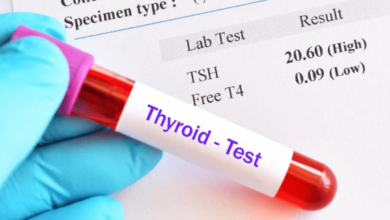
The bacteria Mycobacterium tuberculosis is the cause of tuberculosis (TB), a serious global health issue that affects public health significantly. It is possible to spread the disease of tuberculosis itself. For efficient therapy, it is essential to comprehend tuberculosis (TB), its symptoms, remedies, and preventive measures when a Tuberculosis test is conducted.
In this detailed article, we will go through the subtleties of tuberculosis (TB) to offer useful advice to both patients and medical professionals. TB, whic is commonly known as pulmonary tuberculosis, typically affects the lungs but can expand to other organs. Both the illness and the chance of transmission can be managed for tuberculosis.
What are the Symptoms of Tuberculosis
Three phases of tuberculosis infection progress, each with unique symptoms that indicate the severity of the illness.
1. Initial Symptoms
The immune system may catch TB bacteria during the early stages of initial infection, frequently without any apparent symptoms. If signs and symptoms are present, they could resemble those of the flu, such as a slight fever, fatigue, and weakness.
2. Underlying TB Symptoms
Immune cells usually create a barrier of defense in lung tissue during the latent TB infection stage, usually with no symptoms apparent. However, taking a tuberculosis test can reveal the actual status.
3. Active TB Symptoms
The infection advances to the active stage, which is characterized by symptoms like a persistent cough, pain while breathing or coughing, fever, night sweats, weight loss, exhaustion, and decreased appetite if the immune system is unable to control the TB germs.
Read also: Capital Health Screening Centre: Why Regular Health Check-ups Matter
What Are the Causes of Tuberculosis
Mycobacterium tuberculosis, the bacteria that causes tuberculosis, is mainly transmitted via droplets that are released when an infected person coughs, sneezes or speaks. The germs can only be spread by patients with active TB. Two to three weeks following treatment, tuberculosis cannot typically be transmitted by active TB patients who take medicine on a regular basis. A number of factors raise the possibility of contracting tuberculosis and developing an active illness.
You have a higher risk of contracting tuberculosis if you engage in activities or routines that require you to interact with active TB patients. Those who live or work in high-risk environments, such as a hospital, nursing home, prison, or dorm, or who have close contact with active TB cases are most at risk of contracting the disease. Furthermore, a weakened immune system raises the possibility that a tuberculosis infection will progress to active TB.
Nonetheless, there are certain conditions where the immune system is compromised by underlying medical conditions; these include being underweight or malnourished, alcohol addiction, smoking, long-term steroid use, drug consumption following organ transplant surgery, illicit injection drug use, severe kidney disease, blood, head, and neck cancer, cancer currently undergoing chemotherapy, diabetes, and HIV/AIDS. In addition to these factors, aging can greatly raise the chance of developing active tuberculosis.
How to Diagnose Tuberculosis
Imaging scans, a TB test, and physical examinations are all part of the diagnosing process for tuberculosis. The tests listed below can be used to identify the specific tuberculosis infection.
1. TB Physical Examination
It is a well-known procedure which entails using a stethoscope to examine respiration, looking for swelling in lymph nodes, and looking for indications of an infection with tuberculosis.
2. Tuberculosis Test in Lab
If a tuberculosis infection is suspected, additional testing such as blood, skin, or imaging tuberculosis tests may be required for further evaluation.
3. Sputum Analysis
Sputum BTA test is a specialized examination that is conducted by medical professionals to detect tuberculosis bacteria.
4. Adenosine Deaminase (ADA) Test
One of the most common tests that can help diagnose tuberculosis (TB) in areas other than the lungs, like the brain, spinal cord, and pleural fluid.
5. Skin Test
A skin test involves injecting tuberculin and monitoring the immune system’s response in the swollen area of the skin 48–72 hours later. A positive result (immune system reaction) suggests latent or active tuberculosis infection.
6. Chest X-Ray
This method of TB testing is typically used to do a tuberculosis imaging assessment. Spotting areas on the lungs indicative of an active tuberculosis infection is possible using a chest X-ray.
How can you Prevent Tuberculosis Transmission?
Avoiding contact with active TB cases and putting preventative measures like vaccination and infection control techniques into practice is key to preventing TB transmission.
A TB vaccine can prevent major kinds of tuberculosis, such as the Bacille Calmette-Guerin (BCG) vaccine. From birth, children receive the BCG vaccine either after delivery or before the baby turns one month old. This vaccination protects against tuberculosis. However, it is important to note that adults are not eligible to receive the BCG vaccine.
There are a some recommended measures that anyone diagnosed with TB can take to guarantee that the disease does not spread. First of all, take medicine to stop the infection from becoming active tuberculosis. Furthermore, make sure you take your medication as prescribed if you have been diagnosed with active tuberculosis.
Remember to remain at home and try to limit your interactions. Also, make sure the room you live in has ventilation or windows to preserve air circulation. Additionally, when you meet new individuals, wear a mask. Moreover, When you cough or sneeze, cover your mouth.
How to Treat Tuberculosis
A multidrug regimen given over several months is the standard of care for tuberculosis. The duration of pharmaceutical use for latent tuberculosis (TB) can be three to four months. After that, drug use may continue for four, six, or nine months if active TB is found. All prescription drugs have to be taken to the end.
Drug resistance is decreased via directly observed therapy (DOT), which ensures medication adherence and treatment completion. Drug-resistant tuberculosis presents difficulties, necessitating specific treatment plans and vigilant supervision. The goal of this TB therapy approach is to eradicate existing bacteria from the body and stop the growth of new, drug-resistant germs.
The Final Words
In a nutshell, global health is still at risk from tuberculosis, which calls for coordinated action to stop its spread and effects. Communities can strive toward lowering the burden of tuberculosis and accomplishing the goal of tuberculosis elimination by raising awareness, putting evidence-based interventions into practice, and giving TB care first priority. By working together and continuing to fund TB control initiatives, we can work toward a day when tuberculosis is eradicated.




